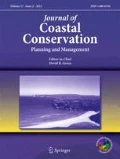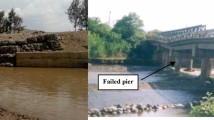Abstract
Engineering infrastructure development usually causes disturbances to environment. Rarely, the natural processes are restored in these physical structures. This paper highlights examples of coexistence of nature and engineering structure in flood control systems in US and Kong Kong, and treats the idea on a new project, a bypass flooding system in Kuching, Malaysia by computer simulation. When the Kuching floodway idles during normal days, it is modelled as a pond to match the surrounding peat swamp. The in-channel pond requires lower flow, allowing the downstream river its natural flows. The modelling simulation shows plausible results to put back nature in man-made system to restrain saline intrusion and problem of low flushing due to flow diversion. With that, it is time to call for the society, particularly the engineering communities to adopt a more nature-sensitive approach in engineering designs.






Similar content being viewed by others
References
Davis SM, Childers DL, Lorenz JJ, Wanless HR, Hopkins TE (2005) A conceptual model of ecological interactions in the mangroves estuaries of the Florida everglades. Wetlands 25:832–842
Endreny TA (2003) Fluvial geomorphology module. UCAR COMET program and NOAA river forecast center, http://www.fgmorph.com, Syracuse, NY
Hey RD (1990) Environmental river engineering. Water Environ J 4(4):335–340
Holman IP, Hiscock KM (1998) Land drainage and saline intrusion in the coastal marshes of Northeast Norfolk. Q J Eng Geol Hydrogeol 31:47–62
Hong Kong Drainage Services Department (2003) Environmental report 2003. Available from http://www.dsd.gov.hk [accessed 27 April 2010]
Jenny KK, Mah DYS, Putuhena FJ, Salim S (2007) Post-flood forensic analysis of Sungai Maong using infoworks river simulation (RS). J Inst Eng Malays IEM 68(4):41–46
Jurutera Jasa Consulting Engineers (2006) Proposed flood mitigation design options for Batu Kitang and Batu Kawa urban centres along Sarawak River, Kuching, Sarawak. Final Report for the State Government of Sarawak, Malaysia
Law PL, Law IN, Lau HH, Kho FWL (2007) Impacts of barrage flushing and flooding-in operations on upstream total suspended solids. Int J Environ Sci Technol 4:75–83
Mah DYS, Lai SH, Chan RA@RB, Putuhena FJ (2010a) Investigative modelling of the flood bypass channel in Kuching, Sarawak by assessing its impacts on the inundations of Kuching-Batu Kawa-Bau Expressway. Structure and Infrastructure Engineering, first published on 23 June 2010 (iFirst), doi:10.1080/15732471003770167
Mah DYS, Bateni N, Putuhena FJ, Lai SH (2010b) Modelling of pumping station in conjunction with Kuching Barrage, Malaysia for flood mitigation. Asian J Water Environ Pollut 7(1):101–106
Myers N (1988) Environmental degradation and some economic consequences in the Philippines. Environ Conserv 15:205–214
Nielsen DL, Brock MA, Rees GN, Baldwin DS (2003) Effects of increasing salinity on freshwater ecosystems in Australia. Aust J Bot 51:655–665
Ritzema HP (2007) The role of drainage in the wise use of tropical peatlands. In: Carbon-climate-human interaction on tropical peatland, Proceedings of the International Symposium and Workshop on Tropical Peatland, Yogyakarta, Indonesia on 27–29 August, EU CARBOBEAT and ReSTORPEAT Partnership, Gadjah Mada University, Indonesia and University of Leicester, United Kingdom
Salim S, Mah DYS, Sumok P, Lai SH (2009) Water quality monitoring of Maong River, Malaysia. Proc Inst Civ Eng Water Manage 162(1):37–42
Santos JM, Ferreira MT, Godinho FN, Bochechas J (2005) Efficacy of a nature-like bypass channel in a Portuguese lowland river. J Appl Ichthyol 21(5):381–388
Shannon NR, Mackinnon PA, Hamill G (2005) Modelling of saline intrusion in marine outfalls. Marit Eng 158:47–58
Sommer T, Harrell B, Nobriga M, Brown R, Moyle P, Kimmerer W, Schemel L (2001) California’s Yolo bypass: evidence that flood control can be compatible with fisheries, wetlands, wildlife and agriculture. Fisheries 26:6–16
Turcotte R, Fortin J-P, Rousseau AN, Massicotte S, Villeneuve J-P (2001) Determination of the drainage structure of a watershed using digital elevation model and a digital river and lake network. J Hydrol 240(3–4):225–242
Wallingford Software (2008) Manual for infoworks river simulation (RS) version 9.0
Wang G, Qian J, Cheng G, Lai Y (2001) Eco-environmental degradation and causal analysis in the source region of the Yellow River. Environ Geol 40:884–890
Winn KO, Saynor MJ, Eliot MJ, Elio I (2006) Saltwater intrusion and morphological change at the mouth of the East Alligator River, Northern Territory. J Coast Res 22(1):137–149
Wösten H (2005) Wise use of tropical peatlands: focus on Borneo. Executive summary of the project “Strategies for Implementing Sustainable Management of Peatlands in Borneo (STRAPEAT)”. International Cooperation with Developing Countries, Contract number ICA4-CT-2001-10098, Alterra, Wageningen, the Netherlands
Young KR (1994) Roads and the environmental degradation of tropical montane forests. Conserv Biol 8(4):972–976
Zimmerer KS (1993) Soil erosion and social (dis)courses in Cochabamba, Bolivia: perceiving the nature of environmental degradation. Econ Geogr 69:312–327
Author information
Authors and Affiliations
Corresponding author
Rights and permissions
About this article
Cite this article
Mah, D.Y.S. Restoring nature in engineering structure: a modelling of Kuching bypass floodway. J Coast Conserv 15, 565–571 (2011). https://doi.org/10.1007/s11852-011-0145-4
Received:
Revised:
Accepted:
Published:
Issue Date:
DOI: https://doi.org/10.1007/s11852-011-0145-4




